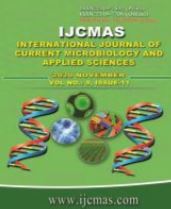


 National Academy of Agricultural Sciences (NAAS)
National Academy of Agricultural Sciences (NAAS)

|
PRINT ISSN : 2319-7692
Online ISSN : 2319-7706 Issues : 12 per year Publisher : Excellent Publishers Email : editorijcmas@gmail.com / submit@ijcmas.com Editor-in-chief: Dr.M.Prakash Index Copernicus ICV 2018: 95.39 NAAS RATING 2020: 5.38 |
Relative performances of ten makhana genotypes were studied at RCM, Darbhanga, during 2017-19, based on yield and morphological characters. The results revealed that the average number of fruits/plant varied from 8.22 in Manipur-9 to 13.16 in Superior Selection-1 (SS-1). The average flowering period up to 50% decomposition was in the range of 111.67 to 140.00 days. The average number of seeds /fruit of the different genotypes varied from 68.11 in Manipur-2 to 94.37 in SS-1. After rigorous study of field harvest, it has been found that Manipur-9 recorded the average minimum field harvest of 2.0 t/ha whereas SS-1 registered the average maximum of 4.2 t/ha followed by SwarnaVaidehi (3.2 t/ha). With regard to seed character, SS-1 had the highest test weight (100 seed weight) of 96.55 g and had attractive rosy purple flowers and increased number of round bold seeds as compared to SwarnaVaidehi. The genotype Manipur -2 had greater number of flowers (13.37/plant) and Selection 27 had higher seed number/fruit (90.21) as compared to traditional SwarnaVaidehi variety. Hence, in the crop improvement point of view, the genotypes SS-1, SwarnaVaidehi, Selection -27 and Manipur-2 were found to be promising. The genotype SS-1 was superior over SwarnaVaidehi with regard to commercial field harvest and fresh biomass production under freshwater wetland ecosystems of north Bihar, India.
 |
 |
 |
 |
 |